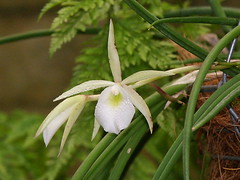Do you love the smell of citrus? If you answered yes, Brassavola orchids may be just the plants for you. Named after the 16th century Italian physician, Antonio Musa Brassavola, these orchids are some of the easiest orchids to cultivate.
Native to the lowlands of Central and South America, Brassavola orchids produce white or greenish white flowers that emit a wonderful citrusy smell. The fragrance is emitted only at night, though, to attract the right moth. The popularity of this genus of 20 different species of orchids dates back to the 17th century when Brassavola nodosa, nicknamed Lady of the Night, was exported from Cuaracao to Holland in 1698.
Some Brassavola orchids are lithophytes, but most are epiphytes. They reproduce via elongated, stem-like pseudobulbs which produce a single succulent leaf. The plants rarely grow higher than ten inches and produce blooms which can last from 5 to 30 days. The blooms are usually white or greenish white and grow singly or in a small raceme or cluster. The flowers are star-shaped and measure one to five inches in width. The “points” of the star consist of three sepals and two lateral petals, all of which are long, narrow and greenish in hue. The lip of the blossom is broad and often fringed, depending on the individual species.
Brassavola orchids will live a long time in low light and in less than 40% humidity. To grow really beautiful plants, though, give them some tender loving care. Provide them with an atmosphere of 60-70% humidity, which can be achieved by placing the pots in a humidity tray or misting. Water at regular intervals when the orchid is almost dried out, and then give the plant a good, long soaking (15 minutes). The roots will absorb the water and get fat and thick, and keep the leaves healthy between watering. Mist daily during the growth season. After the growing season, you can water less often, just be sure not to let the pseudobulbs shrivel.
Temperatures should be kept between 65 and 75 degrees F during the day and no cooler than 55 to 60 degrees at night. Give them plenty of light. These beautiful plants are tough and can take a lot of sun. In fact, they love bright light (2000-3000 foot candles), and will prove it to you by getting freckles. Yes, when a Brassavola orchid is in the correct amount of light, small red freckles form on the leaves. If you don’t see freckles, move the plant to a sunnier location. Place them near a southern-exposure window with good air circulation and these orchids will flourish.
Brassavola orchids can be grown in a pot with drain holes, in slatted baskets or mounted on bark (particularly in tropical climates). A good growth medium would contain perlite, coarse sphagnum peat moss, fir bark and some horticultural charcoal chips. Feed with an orchid fertilizer (at one fourth strength) every third watering. Repot every two to three years.


